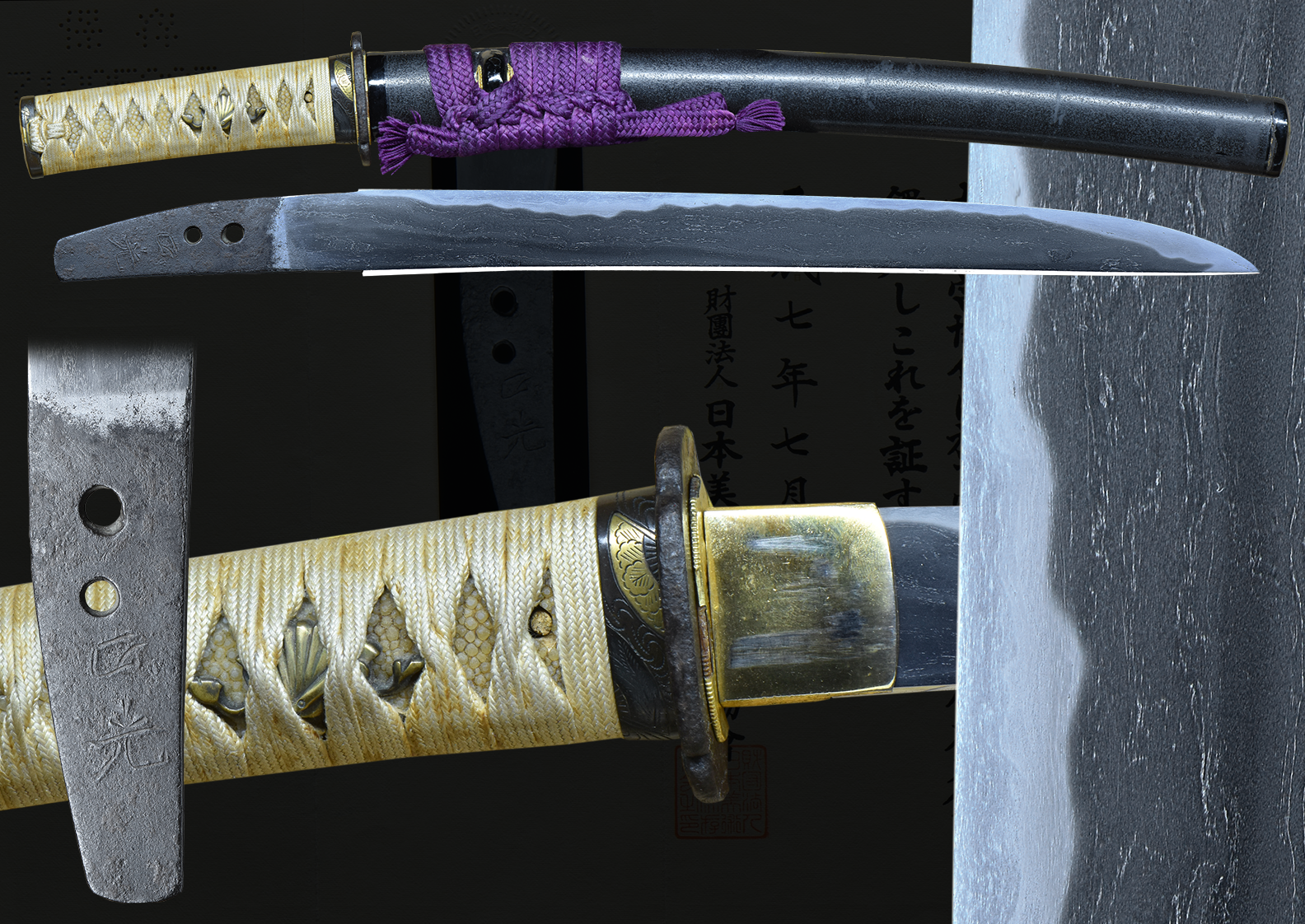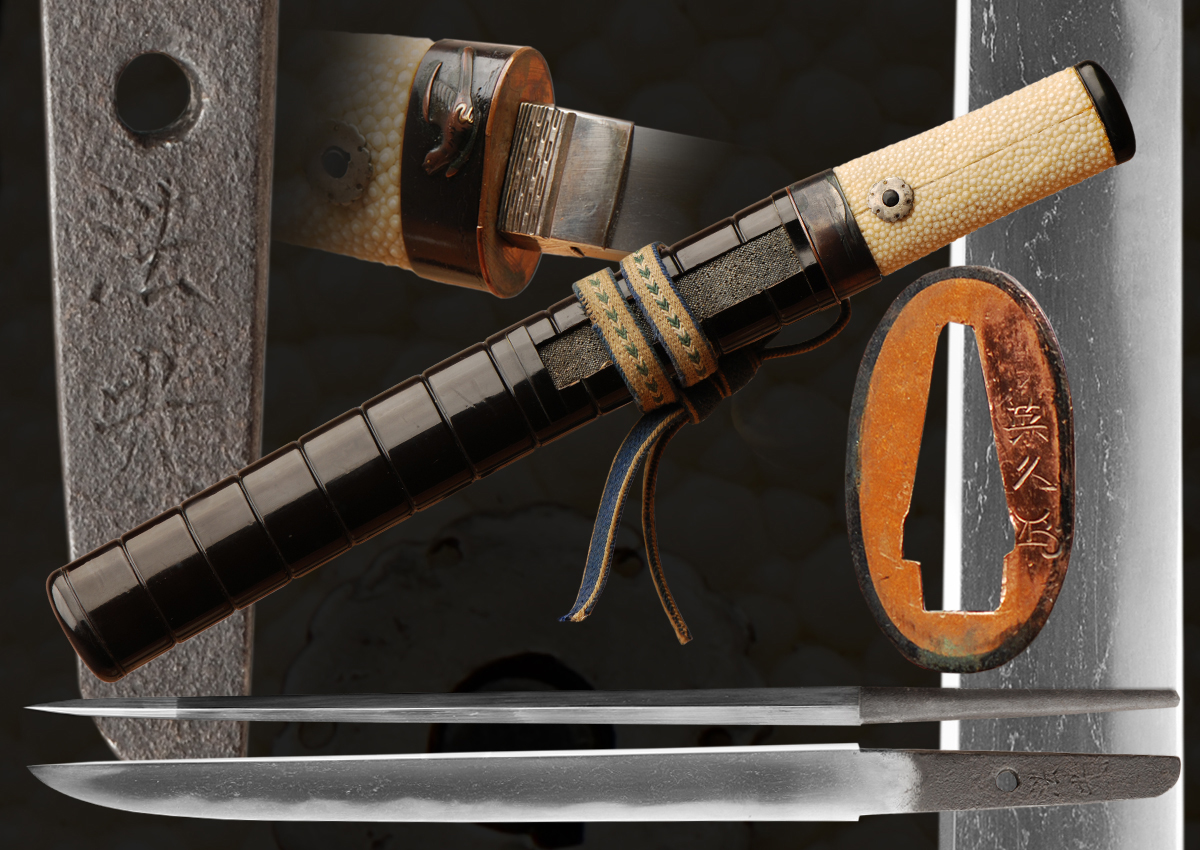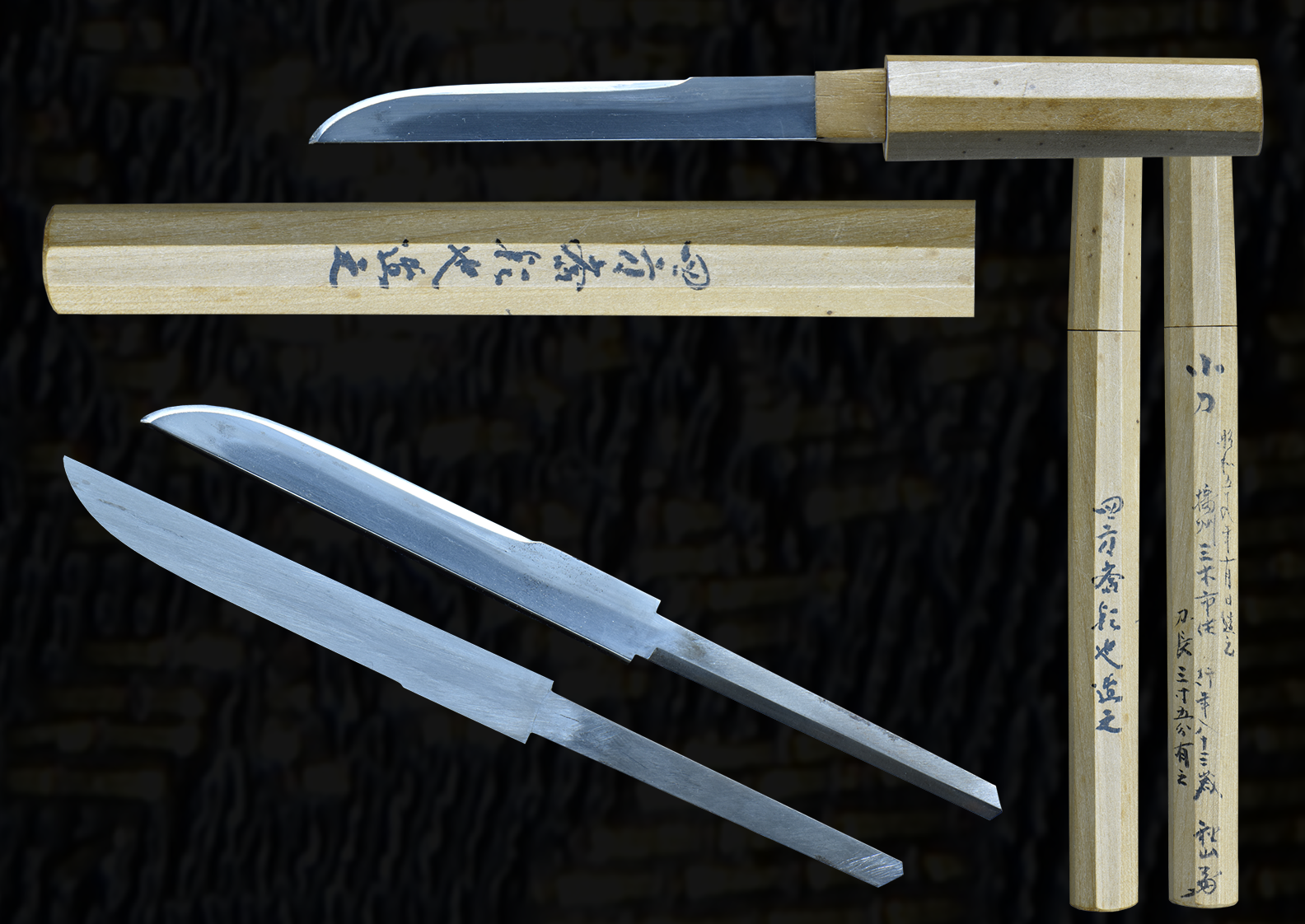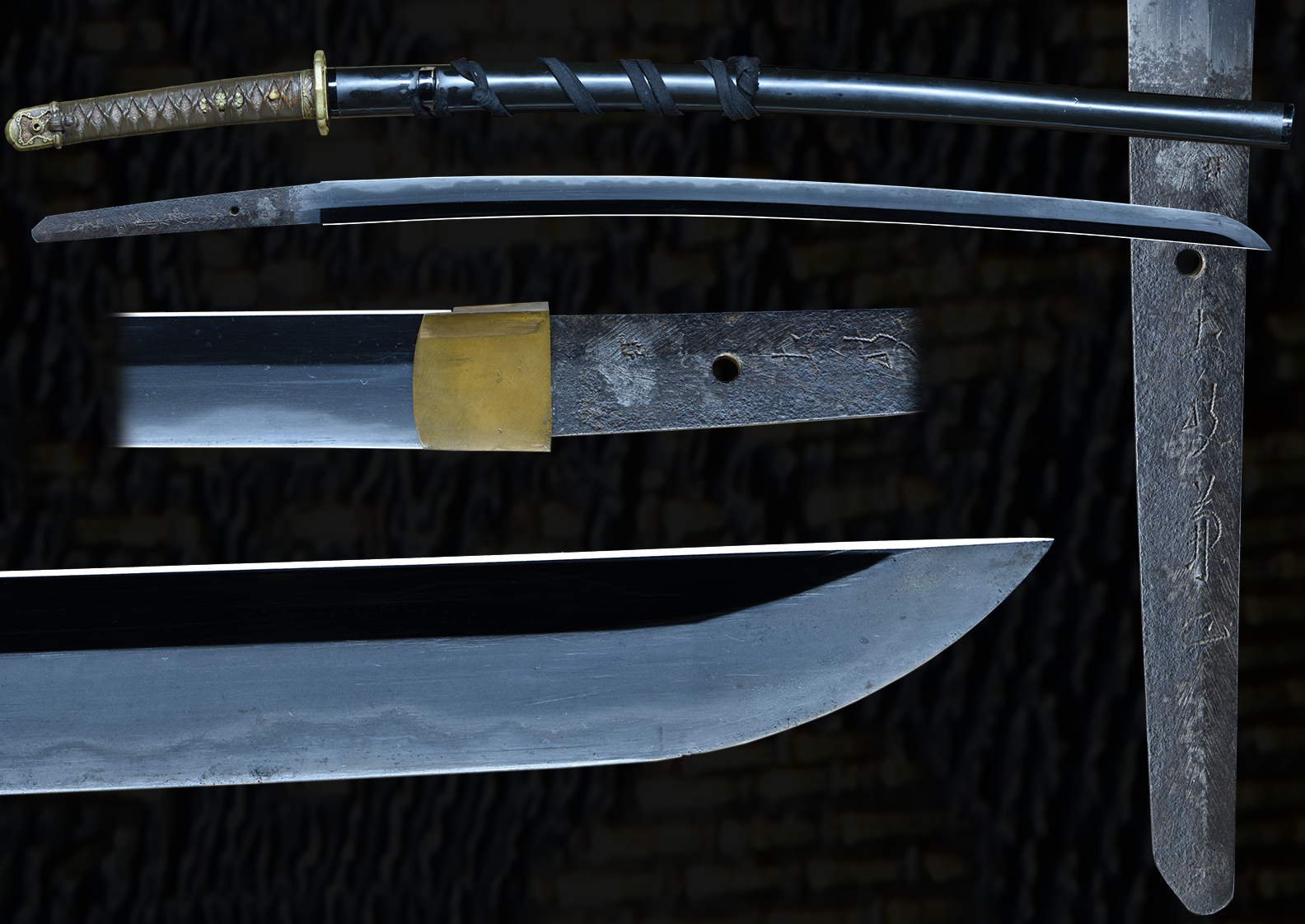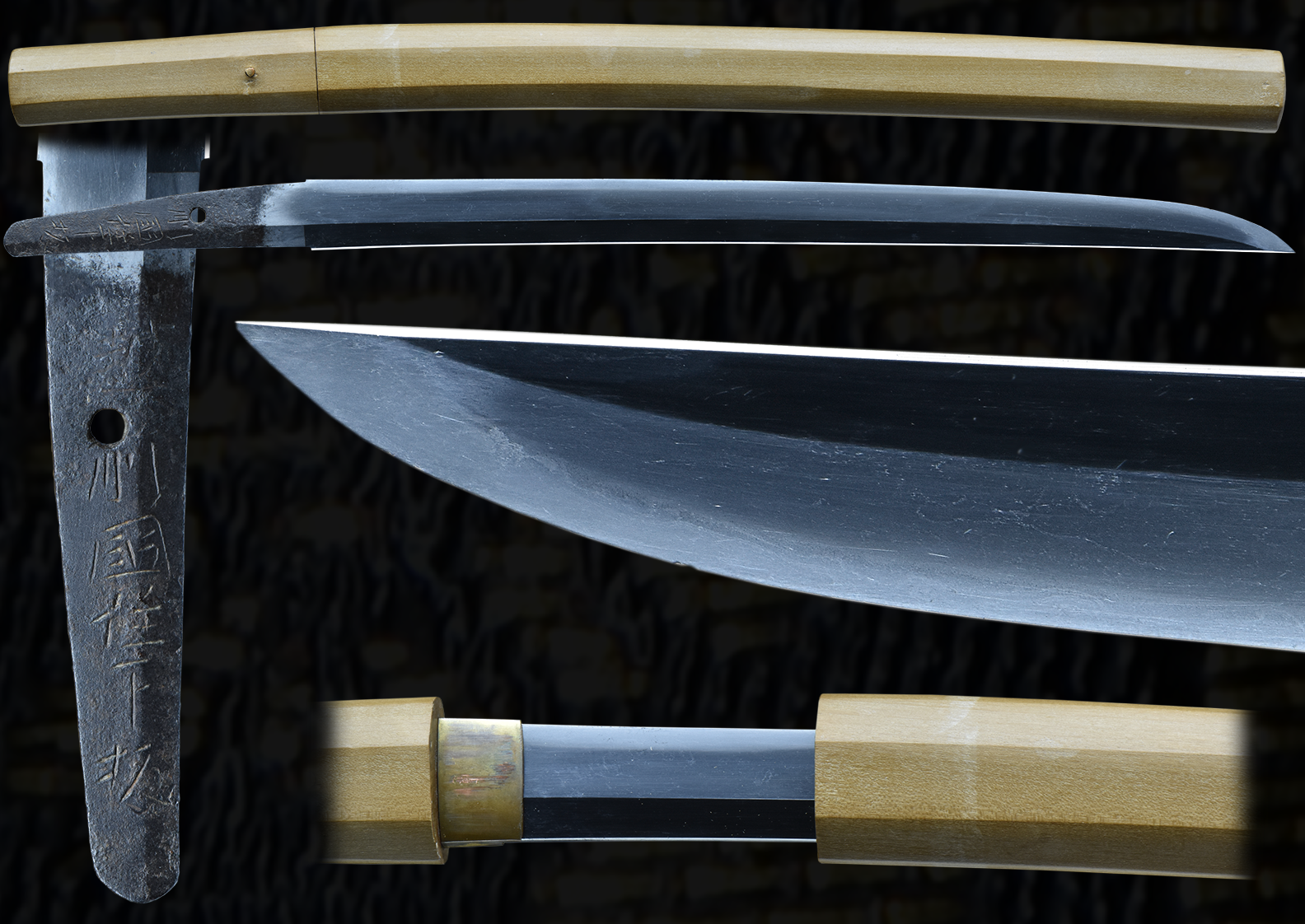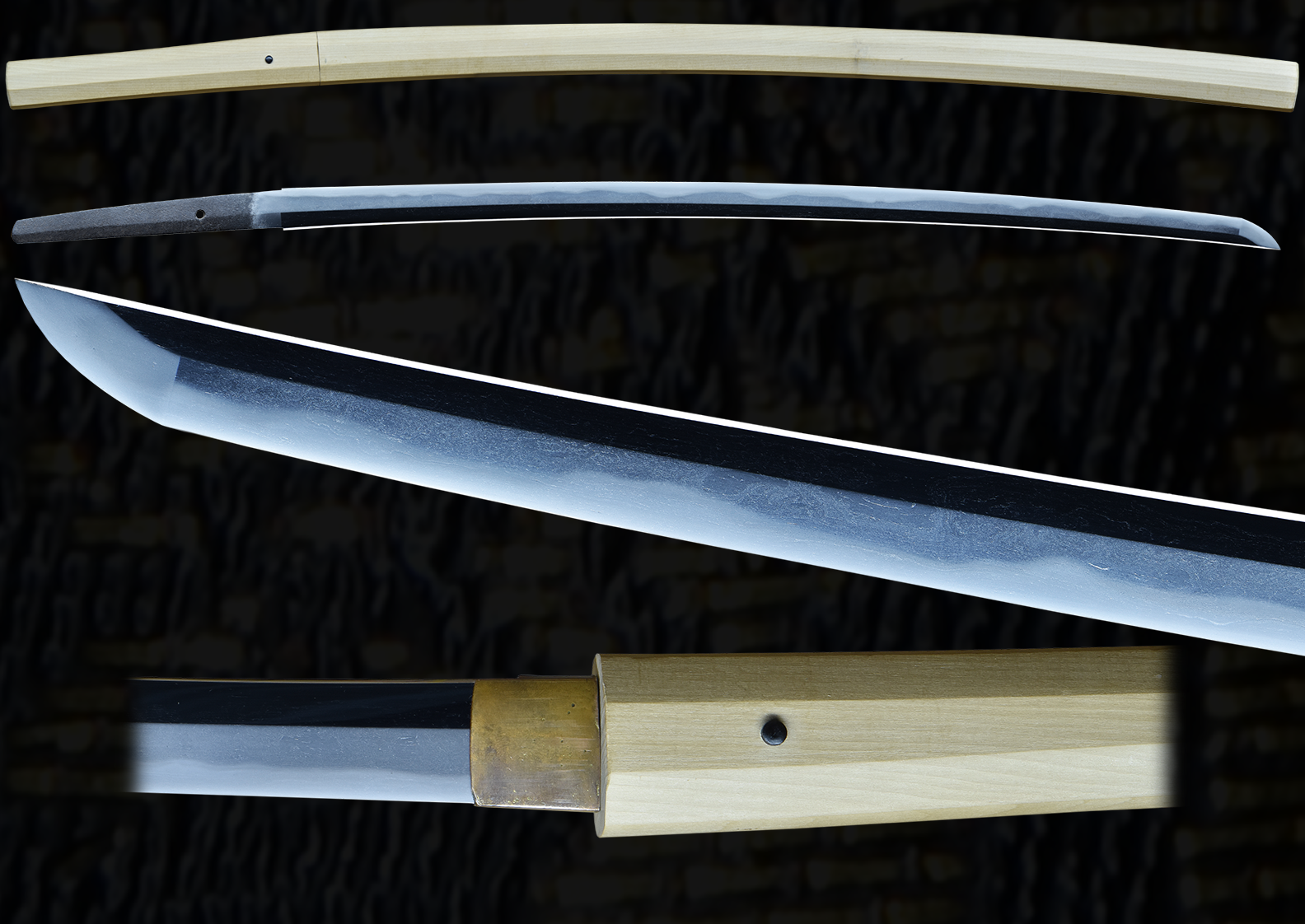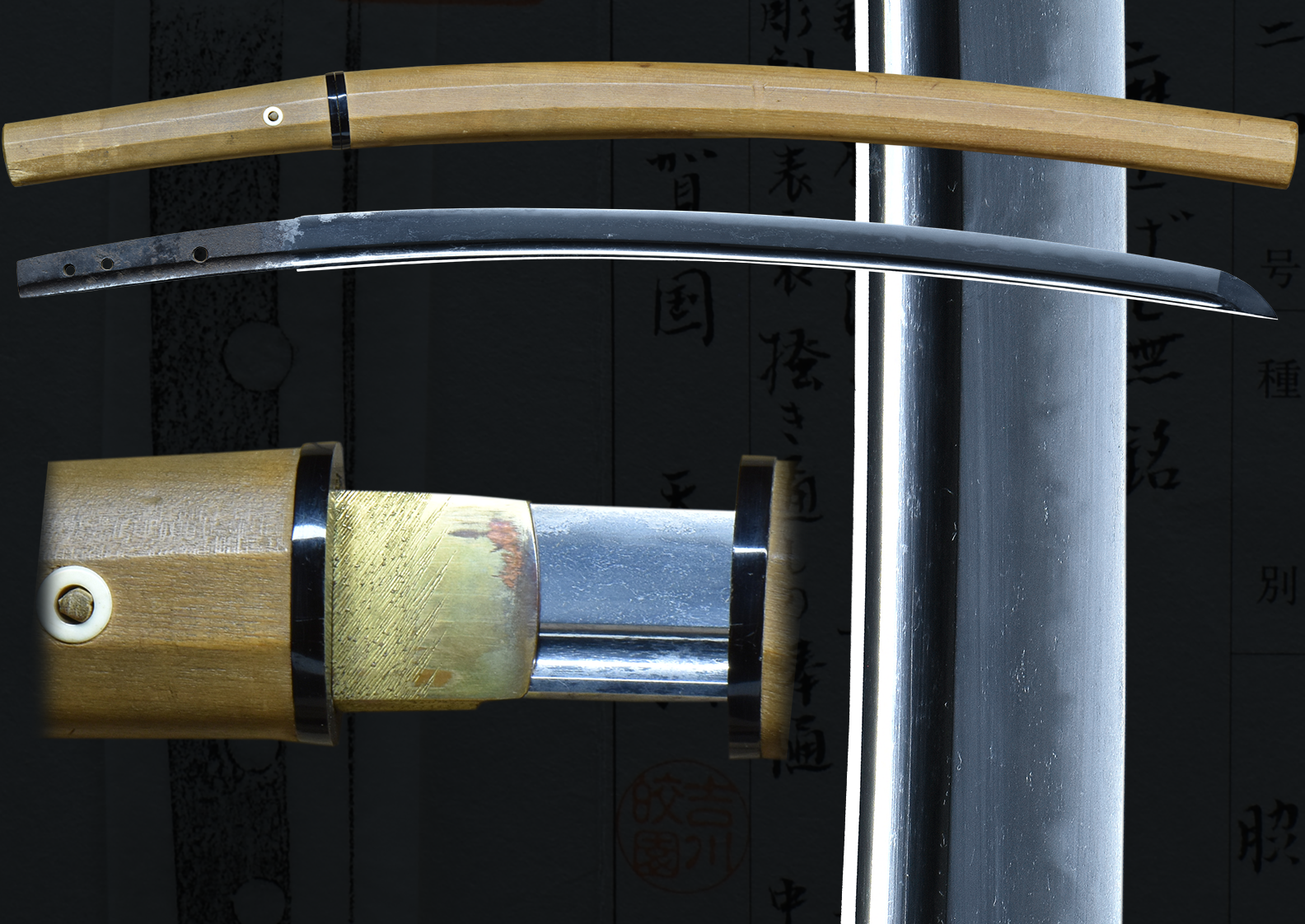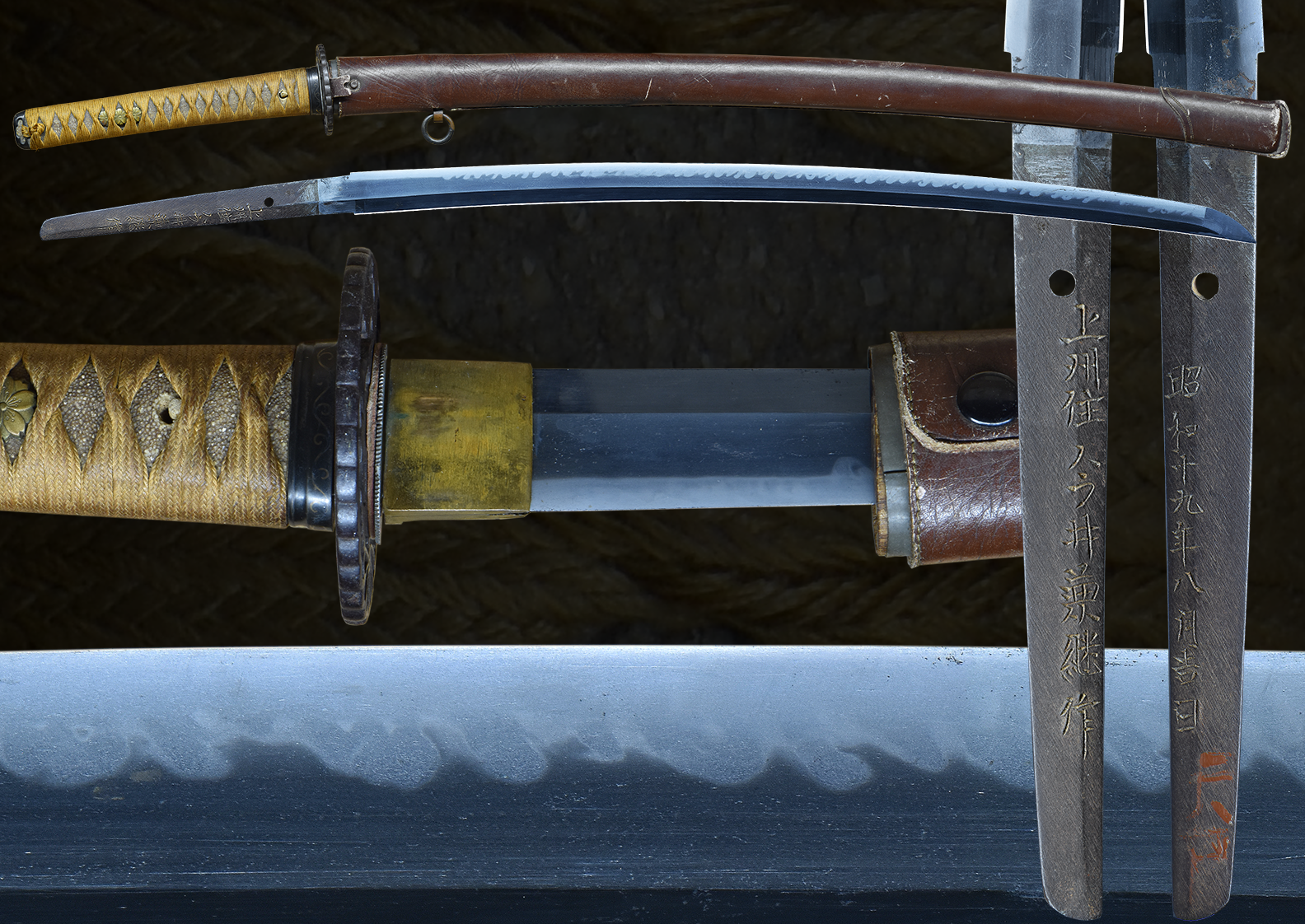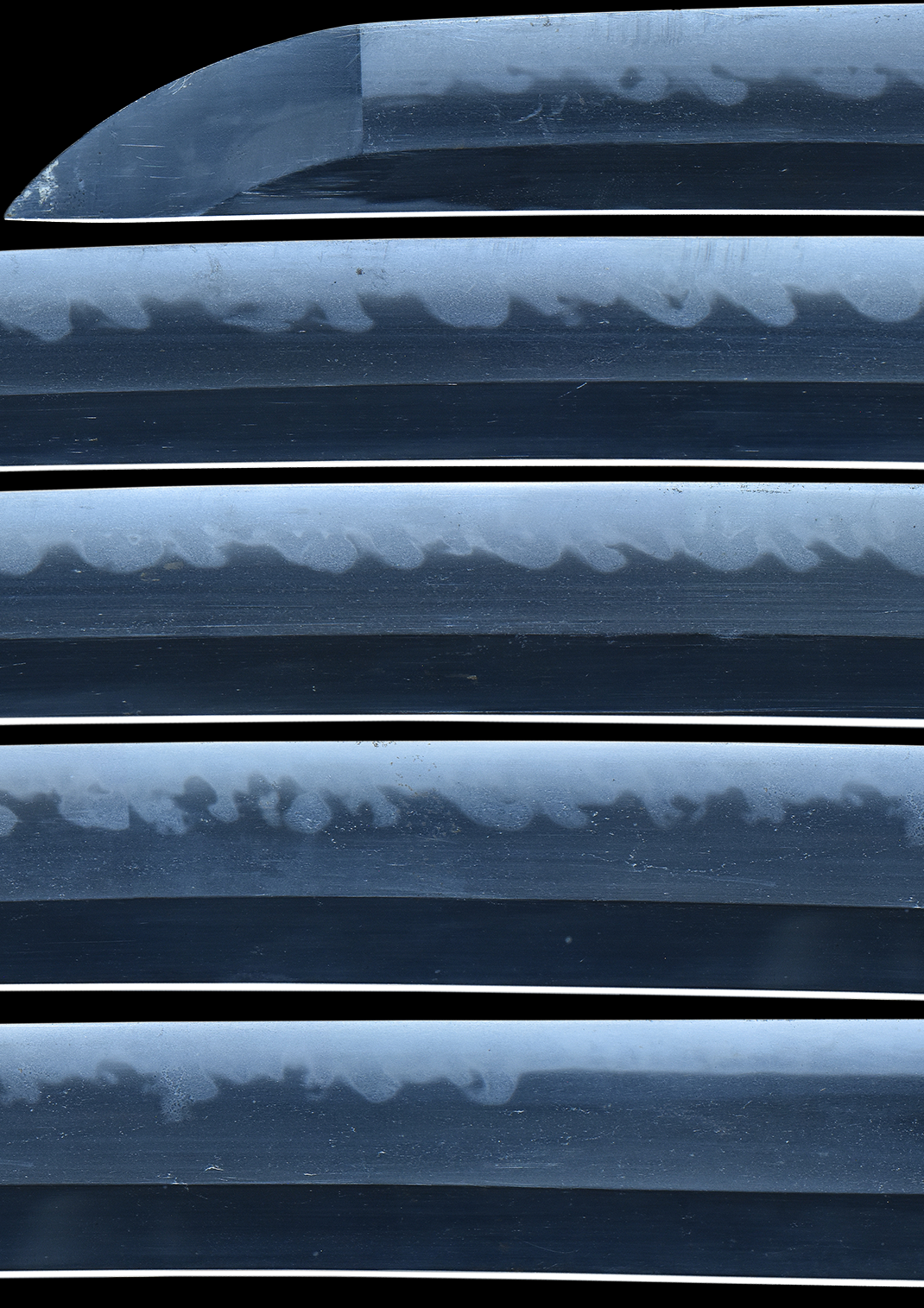JOSHU Ju IMAI KANETSUGU SAKU Gendaito
JOSHU Ju IMAI KANETSUGU SAKU Gendaito WWII Japanese Army Officer’s sword…A very well made blade with a brilliant choji hamon and very tight well defined hada. The blade has some old dried grease and had not been cleaned when the photos were taken. A much better quality blade than commonly seen.
“His real name is Imai Kenzaburo. Kanetsugu began his training as a student of Kiribuchi Kanetomo, but later studied under Kasama Shigetsugu. He used the Go (professional name) of Ryuminsai. During WW2 he served as a Rikugun Jumei Tosho. Kanetsugu died on February 6th, 1971, at the age of 77.”
Medium to High Grade Gendaito
1941 Exhibition – 3rd Seat
His teacher was the well known smith:\ Kane tomo and Kanetsuigu was his first pupil Kanetomo’s lineage and background is as follows:
Background
There are so many things a person could learn about collecting Nihonto. The author, a beginning student in this field, tends to spend more time studying items that are more often encountered at affordable prices–Gendaito–than pre-Meiji pieces.
Because of the generosity of one of my teachers, I was able to study a good katana made by Ryuminsai Kanetomo. He is listed in Hawley’s, KAN2550 and in Toko Taikan. This teacher of mine also provided me with an article about this smith, written by Mr. Yano Tsuneo 矢野恒夫 which was published in the March 1990 issue Token Bijutsu of NBTHK. There is another article from the September 1988 Token Bijutsu about Kanetomo’s teacher, Kaneyuki 兼行, by the same author. The following information about Kanetomo is a direct translation of the first article. It has been augmented by information from the second article mentioned above.
The Birth
Ryuminsai Kanetomo’s original name was Kiribuchi Mataishi 桐渕又市. He was born on the twenty fifth of November, Meiji 10, 1877, in the town of Tomioka Minami Shinden, Gunma prefecture. Historical names for Gunma are Joshu or Kozuke. At his younger age, Kanetomo worked as a kozo which means servant-like pupil at “Kaneishikaji”. It was a swordsmith’s shop, located in a poor and crowded neighborhood of Tomioka. He had a fiery temper and always got into fights with other people.
The Teacher
About the same time, Matsunaga Ryuminsai Kaneyuki 松永龍眠斉兼行 was the Chief Priest 宮司 at the Suwa Jinja 諏訪神社 of Tomioka 富岡. His side business was making swords and knives. Kaneyuki’s original name is Matsunaga Shichiro 松永七郎. He is the eldest son of the Echigo Yoita 越後与板 swordsmith named Matsunaga Michitsugu 松永道次. He learned sword making from his father, and used the art name of Yukitsugu 行次. In Keio 3, 1867, he adapted the studio name of Ryuminsai which means Dragon Sleeping Studio. In Keio 4, 1868, Shichiro became a pupil of the famous smith Aizu no Furukawa Izumi no Kami Kanesada 会津古川和泉守兼定 who made Hijikata Toshizo’s 土方歳三 favorite sword. Hijikata Toshizo is one of the most famous heroic figures found in recent Japanese history. He was the vice captain of Sinsengunmi 新選組 which was formed to challenge the Meiji Restoration. He was defeated and went to Hokkaido to continue his efforts to keep the Samurai spirit alive. He was killed by the government forces eventually. However, Hijikata Toshizo is remembered as a legend among most Japanese people.
Shichiro worked very hard with his new teacher to learn the sword making techniques developed by Goro Masamune. After he had learned how to produce Nashiji (pear grain jihada) successfully; Kanesada let him use the character of “Kane” 兼 in his art name. Since then, the name of Ryuminsai Kaneyuki was used by Shichiro.
In 1869, Ryuminsai Kaneyuki went back to Yoita and worked for the Ii 井伊家daimyo as their swordsmith. After the edict abolishing the wearing of swords was issued in Meiji 9, he had to change his career like almost every other swordsmith. He moved to Tomioka no Suwa Jinja and became the Chief Priest in 1877. In addition to his position with the Suwa Jinja, he made utility and cooking knives as a side business, at which he was very successful. His products won him an award at the third National Bussiness Exposition in Meiji 23. He also made a sword presented to the Niigataken no Yahiko Jinja in Meiji 29.
The Young Swordsmith
When Kanetomo worked at Kaneishikaji, he visited Kaneyuki frequently because of his strong interests in sword making. After the owner of Kaneishikaji died, Kanetomo opened his own shop. In Meiji 33 (1900) Kanetomo became the pupil of Ryuminsai Kaneyuki. That was one of the toughest times in Japanese history to be in the sword making business, but, Kanetomo loved this traditional craft so much, he resolved to become a swordsmith.
In Meiji 41 (1908) Imai Kanetsugu (original name Kenzoro) became Kanetomo’s first pupil. Kanetomo’s situation changed a lot during the next few years. First, on June 3rd, Taisho 2 (1913), Kaneyuki died at the age of sixty nine. Then, Imai Kanetsugu was called to join military service in Taisho 3 (1914). During the Taisho period, sword making activities were slow. As a result, there are not many swords available, now, from that period of time for us to study. In Taisho 12 (1923) Yano Rinzo, art name Tomoshige, became Kanetomo’s second pupil.
In the early Showa period, the demand for Tanto was high. Later, because of increasing military activities, more military swords were commissioned than any other type. In Showa 5 (1930) Tamura Kazuo became the third pupil of Kanetomo. Because Kanetomo did not have a son, he adopted Kazuo to carry on the family name. Kazuo was given the name Kiribuchi Kanemune. This was a time when Ryuminsai Kanetomo became very involved with sword making and related activities.
The Fame
In December of Showa 8 (1933), Kanetomo made a sword to commemorate the birth of Prince Akihito. On the 24th of December 1933, the day after the prince was born, Kotsuke News published an article about Kanetomo and the sword, showing a photo of him in the opening ceremony of sword making in his studio. In Showa 11 (1936), in the second Whole Nation Nihonto Exhibition and Contest, Kanetomo’s work won him the Sosai Meiyo award. The master swordsman, Showa no Kensei, Nakayama Hakudo gave a cutting demonstration with this sword. Kanetomo was so proud of the fact that his work was appreciated by Hakudo, that he inscribed “Nakayama Hakudo Sensei Tameishi Giri Yuryou Naru Mono To Mitomu” on the nakago of that sword. The insription means that Hakudo Sensei tested the sword and attested to its outstanding cutting ability.
Now that Kanetomo was famous, many students came to him wanting to be his pupil and to learn from him. They were Kanekuni in Showa 13, Kaneharu in Showa 14, and Kanechika in Showa 16.
The Gunsuito Project
As wartime activities accelerated, the Japanese Army contracted with Kanetomo to be an army smith. Meanwhile, Tamahagane 玉鋼, the traditional material from which sword were made, became more and more difficult to obtain. Gunsuihagane 群水鋼 was recommended as one substitute material for Tamahagane. Gunsuihagane was produced by Gunma Suiden Kabushiki Kaisha, a hydro electrical power company. The Gunma Suiden Haramachi power plant used sand iron obtained from the Kamugawa 鴨川 seashore of Chibaken 千葉県 in an electrical refining process to make this material for sword and knife production.
Takahashi Tsugumasa was a self-taught swordsmith working for Gunma Suiden, doing research on this new material. The company believed that it would be a great idea to get Kanetomo involved in this project and utilize Kanetomo’s reputation for sword making to fulfill the government need for development of new materials for Nihonto.
Gunma Suiden sent Tsugumasa to Kanetomo to be his pupil and to engage in research with him. Kanetomo gave his new student the art name Kanesada. After only two months of testing Gunsuihagane as a sword making material, Kanesada left Kanetomo and moved to Takasaki. Why he did this before the project was completed is unknown. As a result, Kanetomo and Kanemune were left to develop Gunsuito alone.
At the same time, the war situation became more severe and the demand for military swords increased. Since the supply of traditional Tamahagane could not meet demand, the need for a substitute material became urgent. Gunma Suiden wanted to begin mass production with octagonal bars of Gunsuihagane, however, the research on Gunsuihagane hadn’t yet been finished. Also, Kanetomo, who was very confident in his own abilities, did not want to use this material while it was still in the testing stage. In the end, because of government policies, he and his son Kunimune had no choice but to comply with the plan to mass produce swords of Gunsuito. Cutting test demonstrations and advertisements were conducted to introduce Gunsuito. Because of incomplete research, some failures occurred. One of those was a broken Gunsuito during demonstrations.
Later on, more extensive research was conducted (mainly by Kanemune) to complete the Gunsuito project. Ultimately, the performances of Gunsuito were improved to the level of swords made of Tamahagane. As a result, when evaluating Kanetomo and his works, scholars should not place too much emphasis on the early failures of Gunsuito during research stage. The record of disappointments from those failures needs to be corrected.
During the three periods of Meiji, Taisho, and early Showa, sword making was in its dark age. To carry on the practice of this traditional craft and to fulfill demands for military swords, Ryuminsai Kanetomo, together with many of his students, had done a great deal. The value of their contribution was great. Gunma had never been an important sword- making place in Japan history. There were hardly any swordsmiths who worked in that area. Research done on this group of swordsmiths has very important meaning for understanding the sword making history of Gunma.
- Mei: Joshu ju imai kanetsugu saku
- Date: showa jyu ku nen hachi gatsu hi (a luck day in august 1944)
- Nagasa: 25-1/4 inches
- Sori: 18.0 mm
- Width at the ha-machi: 30.0 mm
- Width at the yokote: 21.6 mm
- Thickness at the mune-machi: 8.6 mm
- Construction: Shinogi zukuri
- Mune: Iori
- Nakago: Ubu
- Kitae: Itame/mokume
- Hamon: Chogi
- Boshi: Maru
- Condition: Original polish
Asking price: $4,400.00
(shipping and insurance included)
Email us if your interested in this item and remember to include the order number for this item: fss-907.
Click to Enlarge Image
Click to Enlarge Image
For Sale
